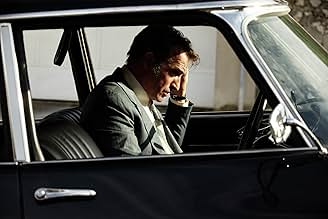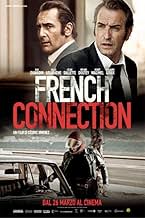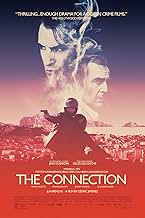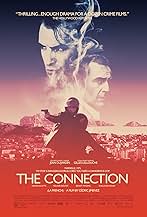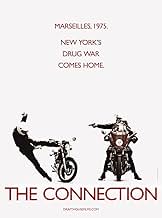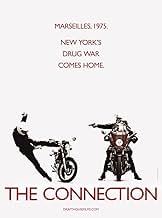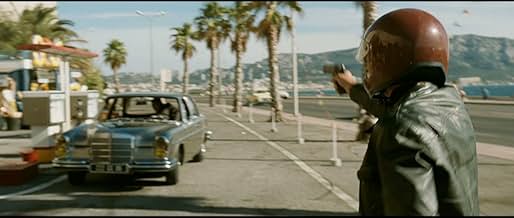IMDb रेटिंग
7.1/10
13 हज़ार
आपकी रेटिंग
अपनी भाषा में प्लॉट जोड़ेंA French police magistrate spends years trying to take down one of the country's most powerful drug rings.A French police magistrate spends years trying to take down one of the country's most powerful drug rings.A French police magistrate spends years trying to take down one of the country's most powerful drug rings.
- निर्देशक
- लेखक
- स्टार
- पुरस्कार
- 2 जीत और कुल 5 नामांकन
फ़ीचर्ड समीक्षाएं
This is the other half of the story of seventies classic - 'The French Connection. Jean Dujardin ('The Artist') plays Magistrate Pierre Michel who in 1974 gets promoted to deal with organised crime in Marseilles. Gilles Lellouche ('Mea Culpa' and 'Mesrine') plays the drugs uber lord 'Tany' – who rules with an iron fist and any other implement that can come to hand. He runs a crime network that includes night clubs, casinos and restaurants and will do anything to keep what he has and make tons more cash
This is one of those times when crims made so much money that they could buy their way out of trouble – even before they were in it. So inevitably Michel has more than the crooks to do battle with. It follows the story from the mid seventies and into the eighties and it is one helluva ride.
The period detail is excellent, the cars, fashions and the music are all spot one – even the decor. There is violence and plenty of potty mouth goings on, but it is all in context. It is also a stylish film that means that most shots are great to look at as well as being intensely entertaining. This is a film that should get a lot more attention and if you are a stranger to French cinema it may be a good one to start with to see just how well they can make them.
This is one of those times when crims made so much money that they could buy their way out of trouble – even before they were in it. So inevitably Michel has more than the crooks to do battle with. It follows the story from the mid seventies and into the eighties and it is one helluva ride.
The period detail is excellent, the cars, fashions and the music are all spot one – even the decor. There is violence and plenty of potty mouth goings on, but it is all in context. It is also a stylish film that means that most shots are great to look at as well as being intensely entertaining. This is a film that should get a lot more attention and if you are a stranger to French cinema it may be a good one to start with to see just how well they can make them.
In the late 1960s and early 1970s drugs were flowing from Marseille to New York in a sophisticated and sustained operation. The Americans made two movies about the racket: "The French Connection" (1971) set in New York and "The French Connection II" (1975) located in Marseiiles, in both cases with Gene Hackman famously playing the police crime-buster. French cinema too has had two cracks at telling the story: first with "The Judge" (1984) and then with "The Connection" ("La French" in French) in 2014.
In the French films, the hero is not a policeman but a magistrate, in "The Connection" played by played by Jean Dujardin, best known outside France for his performance in the silent film "The Artist". The role of the chief criminal is taken by Gilles Lelouche. There is a short scene where the two meet alone which is reminiscent of the cafe scene between Al Pacino and Robert de Niro in "Heat". "The Connection" is not one of the the classics like "The French Connection" and "Heat" but it is a stylish, if clichéd, thriller with hand-held camera-work and atmospheric soundtrack adding to the impact.
In the French films, the hero is not a policeman but a magistrate, in "The Connection" played by played by Jean Dujardin, best known outside France for his performance in the silent film "The Artist". The role of the chief criminal is taken by Gilles Lelouche. There is a short scene where the two meet alone which is reminiscent of the cafe scene between Al Pacino and Robert de Niro in "Heat". "The Connection" is not one of the the classics like "The French Connection" and "Heat" but it is a stylish, if clichéd, thriller with hand-held camera-work and atmospheric soundtrack adding to the impact.
Great movie. You can feel the 1970-1980 life. And a good guy-bad guy battle, with the comparisons, is not bad actually. The selection of actors is very good to. This non static movie remind me to the earlier movie "The French Connection", with a similitude, but this movie is recorded with the Hollywood modern way. The faces of the actors remind me to that era to. I only miss a revenge to a judge's family, but never happens. This Movie is a great deal for Action-Triller lovers. Love the colors and this sepia effects in some frames. If you love action films of earlier eras, this is a movie for you. Beautiful story, good actors and great landscapes. Recomendable
If I could only recommend you go and see one film this year, The Connection would be it.
The film follows the true story of the rise and fall of Pierre Michel "The Judge", played by The Artist's Oscar winning Jean Dujardin, against the Marseillaise mafia gang The French Connection in the 1970s. The story had already been put to cinema in The Judge (1984), but this time the story's been redone much more ambitiously.
It's a typical good guy versus bad guy story, but it's the bells and whistles in this film that really make it so much more than that. The director achieves the perfect combination of action, drama, comedy and tragedy with the irrepressible Mediterranean sun beating down on every day time scene in the film. The Mediterranean settings give the film a sense of glamour and surrealism, juxtaposing the surreal nature of life as a successful drug trafficker in the 1970s, passing time between seaside villas and the biggest nightclub in Marseille.
This is film making at its best - it's as if the screen writer and director Cédric Jimenez pulled out an old school book of film making craft written in the 1970s and followed all the old rules to perfection to bring about not only a brilliant piece of cinematic entertainment, but also of art. This film is a living, breathing and intimate nostalgic reinvention of the 1970s and a just and accurate portrayal of a real gangster story, with some liberties in representing the character's private lives.
Cédric Jimenez grew up himself in Marseille in the 1970s and says that the story of the Judge has run through his veins his whole life. He has wanted to make this film as long as he has wanted to be a film maker, starting his career initially as a documentary maker. He chose to shoot the whole film with a hand held camera, which gives the film it's intimate and raw feeling.
It is an absolute viewing pleasure to be immersed back into the 1970s era and the sets and costumes have been rendered to perfection, to every last detail. The velour furniture, the dingy nightclubs, the glamorous dresses and old style police surveillance technologies are a delight to rediscover. The cowboy style of policing in the 1970s makes the action scenes much more exciting than anything depicting the risk-averse 2000s - the only person in the film wearing even a bullet proof vest is the gang leader Gaëtan "Tany" Zamper (Gilles Lellouche).
There are countless unforgettable scenes in this film, the dialogue is witty, the action is edgy and the acting is superb. Another highlight is the film's soundtrack featuring endless classics from the 1970s (Blondie, Kim Wilde and the Velvet Underground) and tunes by composer Guillaume Roussel that reflect the film soundtracks of the time (for example, his tune Meurtre de fou). It can be tough to watch a sub-titled film for 2h15min, but believe me it's worth it.
The film follows the true story of the rise and fall of Pierre Michel "The Judge", played by The Artist's Oscar winning Jean Dujardin, against the Marseillaise mafia gang The French Connection in the 1970s. The story had already been put to cinema in The Judge (1984), but this time the story's been redone much more ambitiously.
It's a typical good guy versus bad guy story, but it's the bells and whistles in this film that really make it so much more than that. The director achieves the perfect combination of action, drama, comedy and tragedy with the irrepressible Mediterranean sun beating down on every day time scene in the film. The Mediterranean settings give the film a sense of glamour and surrealism, juxtaposing the surreal nature of life as a successful drug trafficker in the 1970s, passing time between seaside villas and the biggest nightclub in Marseille.
This is film making at its best - it's as if the screen writer and director Cédric Jimenez pulled out an old school book of film making craft written in the 1970s and followed all the old rules to perfection to bring about not only a brilliant piece of cinematic entertainment, but also of art. This film is a living, breathing and intimate nostalgic reinvention of the 1970s and a just and accurate portrayal of a real gangster story, with some liberties in representing the character's private lives.
Cédric Jimenez grew up himself in Marseille in the 1970s and says that the story of the Judge has run through his veins his whole life. He has wanted to make this film as long as he has wanted to be a film maker, starting his career initially as a documentary maker. He chose to shoot the whole film with a hand held camera, which gives the film it's intimate and raw feeling.
It is an absolute viewing pleasure to be immersed back into the 1970s era and the sets and costumes have been rendered to perfection, to every last detail. The velour furniture, the dingy nightclubs, the glamorous dresses and old style police surveillance technologies are a delight to rediscover. The cowboy style of policing in the 1970s makes the action scenes much more exciting than anything depicting the risk-averse 2000s - the only person in the film wearing even a bullet proof vest is the gang leader Gaëtan "Tany" Zamper (Gilles Lellouche).
There are countless unforgettable scenes in this film, the dialogue is witty, the action is edgy and the acting is superb. Another highlight is the film's soundtrack featuring endless classics from the 1970s (Blondie, Kim Wilde and the Velvet Underground) and tunes by composer Guillaume Roussel that reflect the film soundtracks of the time (for example, his tune Meurtre de fou). It can be tough to watch a sub-titled film for 2h15min, but believe me it's worth it.
The must use adjectives are thrilling and mind blowing. Seriously, the motion picture directed and written by Cédric Jimenez was emotionally heavy. The movie was inspired by true events set in the 1970s. It was about a Neapolitan Mafia Boss Tanny Zampa who ran a French extortion gang in Marseille, France. The Kingpin and his mob later exploded into 'The Connection'. It meant heroin purchased from Turkey being flood into New York by the French Mafia. What stood in their way was dedicated detective Pierre Michel who raged bloody war against their money laundering Empire.
In addition, this action packed Noir was set in Marseille, France. I loved how the opening scene exposed a landscape filled with historical buildings, palm trees, straight roads and the sea that reflected blue from the sky. The vibrating and aggressive sound from the motorbike gave the picture a dramatic sound. Expressive music which featured a woman singing her heart out gave a lovely mood. The song was Jerome sang by Lykke Li. Bang! Bang! Bullets flashed at a car driver on the streets. Hit men on motorbike were like characters from a western movie shooting down their victim. The act created a contrast from beautiful to horrendous.
What is more, the tense violence gave the film justice. It empathised the horrors of the French Mafia who imported tons of heroin from Turkey to France and New York City. The pace was very fast. It demonstrated how society was corrupt by dangerous mobsters who rhymed with monsters. The viciousness contained scenes of Zampa and his henchmen killing those who did not pay up protection rackets. The shootings would be extremely loud and bloody. Graphic tortures was like a rakish rhythm in the content. It showed how evil bloodbaths were. There are media reports of President Nixon declaring war against drugs. This showed what impact on drug affairs did on lives.
Moreover, Tanny Zampa was like a black and white painting. He loved his family and destroyed his enemies. He owned a fabulous club in Marseille. The dedicated detective Pierre Michel was hungry to bring an end to 'The Connection'. Pierre went to the extent in taking the law into his own hands to expose his patriotic nature. The two main contrasting characters had their glorious rise and tragic downfalls.
To add, a scene which I also liked the most was when Tanny and his thugs interrogated their extortion victim. The sufferer was strapped to a chair. He wore his fabulous tuxedo. The room had silver walls. The scene played classic disco music which empathised disturbing psychology on mobsters killing legit people who did not pay up protection rackets. A gunned down casino owner. Left to bleed in a car park in broad day light. Tanny and his boys walked off like it just was business nothing personal.
To carry on, the visualisation had some glimpse shots, fast forwarding and an expression in chiaroscuro. The film looked like a production from the 1970s. This helped empathise the time period. Laurent Tangy as the cinematographer expressed the contrast between light and shade. It resulted to the picture having a dark and light atmosphere. From urban to a reveal location, the lighting exposed the two different worlds. In Tanny's nightclub the cinematographer strengthen the shade and exaggerated the lighting. The high saturation was the icing on the cake. The camera shots in the French picture had long distance shots, up right footages and birds eye view. This implied the importance of society.
As a continuation, soundtrack included an orchestra, disco music and electronic. The sound effects in the film created a tense tone. It backed up how 'The Connection' had a negative effect on Marseille and New York. The emotionally heavy orchestra which was played in the end implied the tragic downfalls of the two opposing characters. Detective Pierre was shot and left to death in his neighbourhood. Crime Boss Tanny was finally arrested as his Empire crumbled.
For the story itself, all I can say is that it was about time to have a cinematic film about the rise and the downfall of the French heroin connection based in the 1970s. Watching the same old Sopranos could not compete with this breed of Gangsterism due to the fact that 'The Connection' focused on the sociological theme. The content was unique, because I was getting bored watching the same old Italian wise guys like 'Goodfellas', 'Mean Streets' and 'The Sopranos.' Those three titles do not go into political depth. Cinema needs more genres which are so different.
All in all, I give this film a solid .. 8/10.
In addition, this action packed Noir was set in Marseille, France. I loved how the opening scene exposed a landscape filled with historical buildings, palm trees, straight roads and the sea that reflected blue from the sky. The vibrating and aggressive sound from the motorbike gave the picture a dramatic sound. Expressive music which featured a woman singing her heart out gave a lovely mood. The song was Jerome sang by Lykke Li. Bang! Bang! Bullets flashed at a car driver on the streets. Hit men on motorbike were like characters from a western movie shooting down their victim. The act created a contrast from beautiful to horrendous.
What is more, the tense violence gave the film justice. It empathised the horrors of the French Mafia who imported tons of heroin from Turkey to France and New York City. The pace was very fast. It demonstrated how society was corrupt by dangerous mobsters who rhymed with monsters. The viciousness contained scenes of Zampa and his henchmen killing those who did not pay up protection rackets. The shootings would be extremely loud and bloody. Graphic tortures was like a rakish rhythm in the content. It showed how evil bloodbaths were. There are media reports of President Nixon declaring war against drugs. This showed what impact on drug affairs did on lives.
Moreover, Tanny Zampa was like a black and white painting. He loved his family and destroyed his enemies. He owned a fabulous club in Marseille. The dedicated detective Pierre Michel was hungry to bring an end to 'The Connection'. Pierre went to the extent in taking the law into his own hands to expose his patriotic nature. The two main contrasting characters had their glorious rise and tragic downfalls.
To add, a scene which I also liked the most was when Tanny and his thugs interrogated their extortion victim. The sufferer was strapped to a chair. He wore his fabulous tuxedo. The room had silver walls. The scene played classic disco music which empathised disturbing psychology on mobsters killing legit people who did not pay up protection rackets. A gunned down casino owner. Left to bleed in a car park in broad day light. Tanny and his boys walked off like it just was business nothing personal.
To carry on, the visualisation had some glimpse shots, fast forwarding and an expression in chiaroscuro. The film looked like a production from the 1970s. This helped empathise the time period. Laurent Tangy as the cinematographer expressed the contrast between light and shade. It resulted to the picture having a dark and light atmosphere. From urban to a reveal location, the lighting exposed the two different worlds. In Tanny's nightclub the cinematographer strengthen the shade and exaggerated the lighting. The high saturation was the icing on the cake. The camera shots in the French picture had long distance shots, up right footages and birds eye view. This implied the importance of society.
As a continuation, soundtrack included an orchestra, disco music and electronic. The sound effects in the film created a tense tone. It backed up how 'The Connection' had a negative effect on Marseille and New York. The emotionally heavy orchestra which was played in the end implied the tragic downfalls of the two opposing characters. Detective Pierre was shot and left to death in his neighbourhood. Crime Boss Tanny was finally arrested as his Empire crumbled.
For the story itself, all I can say is that it was about time to have a cinematic film about the rise and the downfall of the French heroin connection based in the 1970s. Watching the same old Sopranos could not compete with this breed of Gangsterism due to the fact that 'The Connection' focused on the sociological theme. The content was unique, because I was getting bored watching the same old Italian wise guys like 'Goodfellas', 'Mean Streets' and 'The Sopranos.' Those three titles do not go into political depth. Cinema needs more genres which are so different.
All in all, I give this film a solid .. 8/10.
क्या आपको पता है
- ट्रिवियाThe Gaumont animated opening logo is the 70's one.
- गूफ़An early title card indicates the film taking place beginning in 1975. A shot of a truck being unloaded on a New York dock shows the World Trade Center Twin Towers under construction. The Twin Towers were opened in 1973, with construction completed prior to that.
टॉप पसंद
रेटिंग देने के लिए साइन-इन करें और वैयक्तिकृत सुझावों के लिए वॉचलिस्ट करें
- How long is The Connection?Alexa द्वारा संचालित
विवरण
- रिलीज़ की तारीख़
- कंट्री ऑफ़ ओरिजिन
- आधिकारिक साइट
- भाषाएं
- इस रूप में भी जाना जाता है
- The Connection
- फ़िल्माने की जगहें
- La Ciotat, Bouches-du-Rhône, फ़्रांस(seaside road)
- उत्पादन कंपनियां
- IMDbPro पर और कंपनी क्रेडिट देखें
बॉक्स ऑफ़िस
- बजट
- $2,60,00,000(अनुमानित)
- US और कनाडा में सकल
- $1,90,980
- US और कनाडा में पहले सप्ताह में कुल कमाई
- $10,335
- 17 मई 2015
- दुनिया भर में सकल
- $1,20,62,441
- चलने की अवधि2 घंटे 15 मिनट
- रंग
- ध्वनि मिश्रण
- पक्ष अनुपात
- 2.35 : 1
इस पेज में योगदान दें
किसी बदलाव का सुझाव दें या अनुपलब्ध कॉन्टेंट जोड़ें








